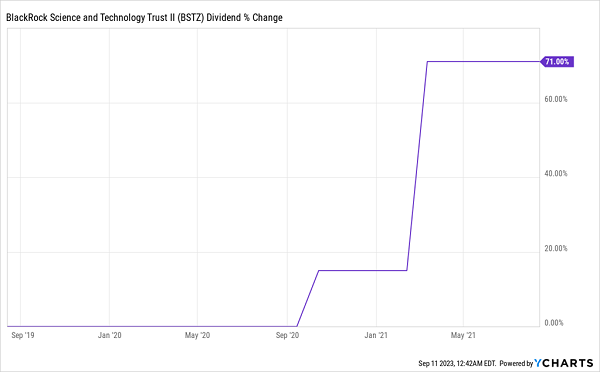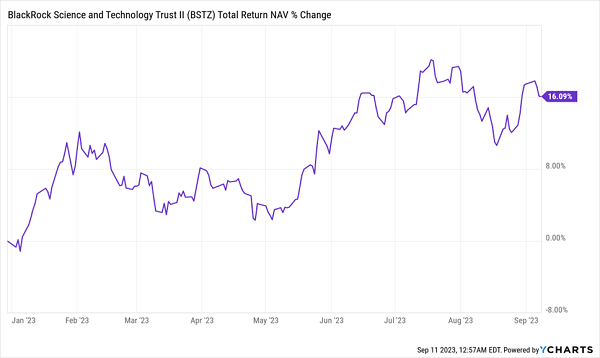Closed-end funds (CEFs) really are the “Swiss army knife” of investments: with one click, they let us grab big income (the average CEF yields 7.9%), diversify (within and beyond asset classes) and buy their holdings for cheap!
But let’s be honest, when it comes to CEFs, it’s all about the dividends.
On that front, there’s a lot to say. For one, many CEFs pay monthly, making managing our income easy: CEFs’ high yields mean we could potentially replace a $6,500 monthly paycheck with less than $1 million invested and live on dividends alone.
And check out these discount and dividend stats from across the CEF space:
- A third of all CEFs yield over 10%.
- 48% of CEFs yield over 8%.
- On average, CEFs yielding over 8% have a 4.9% discount to net asset value (NAV, or the value of their underlying assets).
- 85% of CEFs have some form of discount.
- 43% of CEFs have a discount of 10% or more.
But there are some things about CEFs’ distributions that do make them a little different. Let’s talk about one of those now: what it means when your CEF has a “managed distribution.” For this, we’ll use the BlackRock Science and Technology Term Trust (BSTZ), a holding in my CEF Insider service, as an example.
CEF Distributions: Under the Hood
A lot of people look at CEFs like a bank or a yield-dependent asset, such as a bond. They look first at whether the fund’s distribution is covered by net investment income (NII). For a bond fund, this simply refers to the income it gets from a bond’s issuer.
But this doesn’t work for equity CEFs, as equity funds don’t get NII—they earn a total return from capital gains and dividends. That works out great in strong years, as you can see in the total NAV return of BSTZ, the last big tech CEF to go through an IPO, back in 2019.
BSTZ’s Portfolio Storms Out of the Gate

With its portfolio earning a 136% return in that time, management suddenly had the opposite of a dividend-coverage problem, with an average annualized return far ahead of the 6% yield on the fund’s NAV at its IPO. So it raised the payout:
BSTZ Hands More Profits to Shareholders as Dividends

Even with the hike, which put BSTZ’s dividend at 19.2 cents monthly, the fund was still paying just around 6% on its NAV, on an annualized basis, because this was its mandate: under its managed-distribution policy, it had to keep payouts around 6%.
The payout hike still wasn’t enough to get the NAV return out the door, though, so BSTZ declared a special dividend in late 2021. For BSTZ’s managers, however, this fast rate of change in the distribution made managing the fund’s cash flow challenging. Then came the 2022 pullback.
Back then, the fund’s managed-distribution policy of targeting a 6% payout meant big dividends in 2021 would fall due to the decline in tech stocks in 2022, even though BSTZ’s performance remained fundamentally solid over the long term.
BlackRock fixed the problem with a small (and barely noticeable) change: they’d target distributions of 19.2 cents a share as best they could, instead of targeting 6% payouts (in March 2023, following the 2022 market decline, they did reduce the payout to 16.1 cents to shore up cash and buy back in as the market recovered, a move I expect to reward us through future NAV gains).
Today, tech is recovering and so is BSTZ, so that policy is unnecessary now. That’s why BlackRock announced on September 8 that it would go back to targeting a 6% payout through a managed distribution that managers can change in the future, depending on market conditions.
Since they’d previously pivoted to targeting distribution amounts instead of rates, this pivot back to a 6% distribution rate suggests they believe payouts won’t be drastically cut—and the 6% payout will in fact grow as the fund’s NAV and market price increase.
In other words, this is a confident signal. And it makes sense, now that the tech sector’s crash of 2022 has ended and the recovery, while still slow, is carrying on.
Tech’s Recovery Helps BSTZ Recover, Too

As investors realize BSTZ’s change in distribution reflects management confidence, they’re likely to start buying in. They should be doing so now, with the fund’s 16.4% discount to NAV signaling that retail investors still haven’t figured out that 2022 is over.
This change in distribution is BlackRock stating that not only are distributions no longer at risk of being cut, they’re more likely to grow. As a result, I don’t expect the fund’s discount, its biggest since the start of the pandemic, to last long.
4 CEFs With Monthly Payouts—and 9.5% Yields—We’re Buying Now
For maximum dividend safety and discount-driven upside, I urge you to buy the 4 CEFs I’ll tell you about right here.
As interest rates top out and roll over, more folks will be on the hunt for higher yields—and these 4 funds, with their outsized 9.5% average payout, will look very appealing indeed. We want to front run the crowd into them, which is why now is the time to start a position.
Click here and I’ll share my CEF-investing strategy, including how to spot the best of these profitable—and high-yielding—funds for yourself. I’ll also give you the opportunity to download a Special Report naming these 4 deep-discounted 9.5%-paying CEFs.
